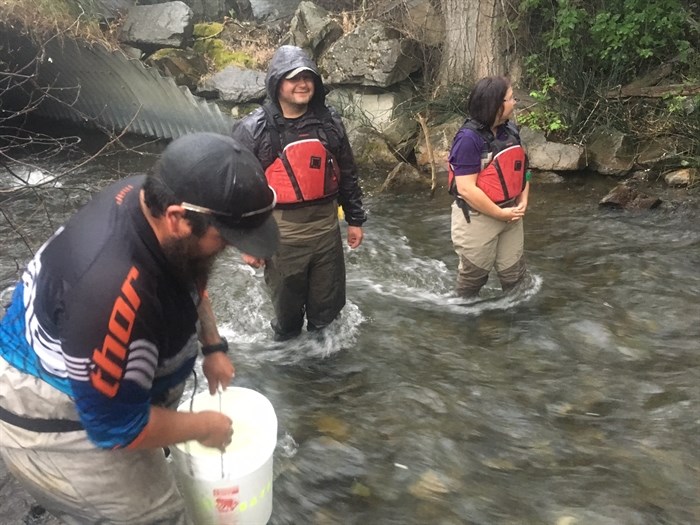
Roughly 3,300 sockeye salmon fry were released into Six Mile Creek, which flows into Okanagan Lake.
Image Credit: Shaylen Smith/ Okanagan Indian Band
June 14, 2016 - 9:00 PM
OKANAGAN - A ceremonial release of thousands of sockeye salmon fry at Six Mile Creek on the Okanagan Indian Band reserve near Vernon this week was a moment band chief Byron Louis will never forget.
In many ways the release symbolized a journey — the years it’s taken to get to this point, and the years ahead, in which the salmon will make their way to the ocean and, hopefully, in a few years, return to Okanagan Lake. Fry were also recently released in Kelowna's Mission Creek and Summerland's Trout Creek.
Oral history and research indicate widespread use of sockeye salmon in the Okanagan by First Nations people many years ago, Louis says, but the construction of dams on Okanagan and Columbia rivers in the 1900s left the fish unable to spawn and resulted in the species becoming extirpated from Okanagan Lake.
He says fresh and dried salmon was an important food source and attributes the loss of that staple food in part to rising diabetes rates among First Nations. But human health is only part of the reason bringing back sockeye salmon is so important, Louis says.
“It’s not only us, we have bears and other types of animal that used to be dependent on the salmon that are impacted by their absence,” Louis says. “Salmon is often described as a keystone species, they have a very important role.”
Louis says efforts have been underway since the early-1990s to reintroduce sockeye to Okanagan Lake, but working with the government has been a slow process. Part of the process included studying the impacts a sockeye salmon release could have on the lake, including competition with existing kokanee salmon populations.
A pilot study was done on Skaha Lake, a much smaller water body compared to Okanagan Lake, over the past 12 years to determine possible impacts. To date, no negative effects have been observed.
“Everything was addressed,” Louis says. “For us it seemed like it was taking forever after that to get them reintroduced in Okanagan Lake.”
The provincial government takes the position it’s too soon to release sockeye salmon fry into Okanagan Lake. In response to a request for an interview, the Ministry of Forests, Lands and Natural Resource Operations sent a written statement saying it has been working with the Okanagan Nation Alliance and Department of Fisheries and Oceans through the Canadian Okanagan Basin Technical Working Group to study the effects of recent sockeye introductions into Skaha Lake.
“This… committee agreed that the necessary scientific work had not yet been done to determine the risk to the distinctive resident kokanee populations in Okanagan Lake from an introduction of sockeye. The province believes we should further advance our understanding of the impacts from… current work prior to undertaking further introduction of sockeye.”
For its part, the federal Department of Fisheries and Oceans confirms it authorized the release. In a written statement, the department says it was approached by the Okanagan Nation Alliance for a permit allowing the controlled release of 350,000 sockeye salmon fry into Okanagan Lake for ceremonial purposes.
“DFO supports authorizing a limited release of fry given that Okanagan sockeye historically existed in the lake and that the requested release would likely be low risk to existing fisheries and fish habitat,” the release states.
However, instead of authorizing the full 350,000 fry, it approved only a release of 10,000 as a precaution.
“The department continues to collaborate with the Okanagan Nation Alliance, Ministry of Forests Lands and Natural Resource Operations, partners and stakeholders in efforts to support the restoration of salmon and associated ecosystems in the Okanagan basin.”
For Louis, he maintains it's within the band’s rights to reintroduce the salmon.
“As far as we’re concerned we said we’re willing to work with the parties and make sure the science is there. We’ve said, and we’ve reminded them continually, our rights and title come into it. We’ve never relinquished our right to manage the species or the environment. We are an authority in ourselves to carry this out.”
But the work didn't end with the release of thousands of baby sockeye. Okanagan Nation Alliance Fisheries manager Howie Wright says the fry will over-winter in the lake before embarking on their journey to the ocean, where they will stay for one to two years before returning to spawn. Only a percentage of the released fry are expected to make it back.
Wright is optimistic that in 15 years or so, there could be a viable sockeye salmon fishery in Okanagan Lake.
“As we learn more about where they’ll spawn, we’ll also look at habitat restoration,” Wright says. “As the salmon move back, we’ll look at when and where we can harvest. It’s pretty exciting.”
To contact a reporter for this story, email Charlotte Helston or call 250-309-5230 or email the editor. You can also submit photos, videos or news tips to the newsroom and be entered to win a monthly prize draw.
We welcome your comments and opinions on our stories but play nice. We won't censor or delete comments unless they contain off-topic statements or links, unnecessary vulgarity, false facts, spam or obviously fake profiles. If you have any concerns about what you see in comments, email the editor in the link above.
News from © iNFOnews, 2016